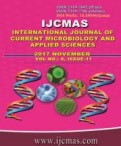


 National Academy of Agricultural Sciences (NAAS)
National Academy of Agricultural Sciences (NAAS)

|
PRINT ISSN : 2319-7692
Online ISSN : 2319-7706 Issues : 12 per year Publisher : Excellent Publishers Email : editorijcmas@gmail.com / submit@ijcmas.com Editor-in-chief: Dr.M.Prakash Index Copernicus ICV 2018: 95.39 NAAS RATING 2020: 5.38 |
Maize is one of the most important cereal crops of the world and contributes to food security in most of the developing countries. In India, maize is emerging as third most important crop after rice and wheat in recent years. The efficient PSB isolates of 24 phospahte solubilizing bacteria isolated from Maize Research Station and College Farm, Rajendranagar, PJTSAU, Telangana, was used in this study. In this study Soil microbial biomass carbon and Maize plant biomass production of was recorded at different growth stages viz., vegetative, flowering and harvesting stages of crop in response to different formulation of PSB and their combination. There was an increasing trend soil microbial biomass was noticed from vegetative to flowering stages and a gradual decrease was observed from flowering stage towards harvesting stage in all the treatments studied. However significant by higher soil biomass carbon was recorded in the treatment T7 - Carrier + Liquid + Biofilmed PSB biofertilizer at vegetative (102.06µg kg-1 of soil microbial biomass carbon and 5.10 g of Plant dry wt), flowering (140.33 µg kg-1 of soil microbial biomass carbon and 15.97 gof Plant dry wt) and at harvesting (121.73µg kg-1 of soil microbial biomass carbon and 32.14 g of Plant dry wt) respectively compared to all other treatments. The major outcome of this study was the Carrier + Liquid + Biofilmed PSB biofertilizer treated Maize (Zea mays) plants produces highest biomass than other treatments.
 |
 |
 |
 |
 |